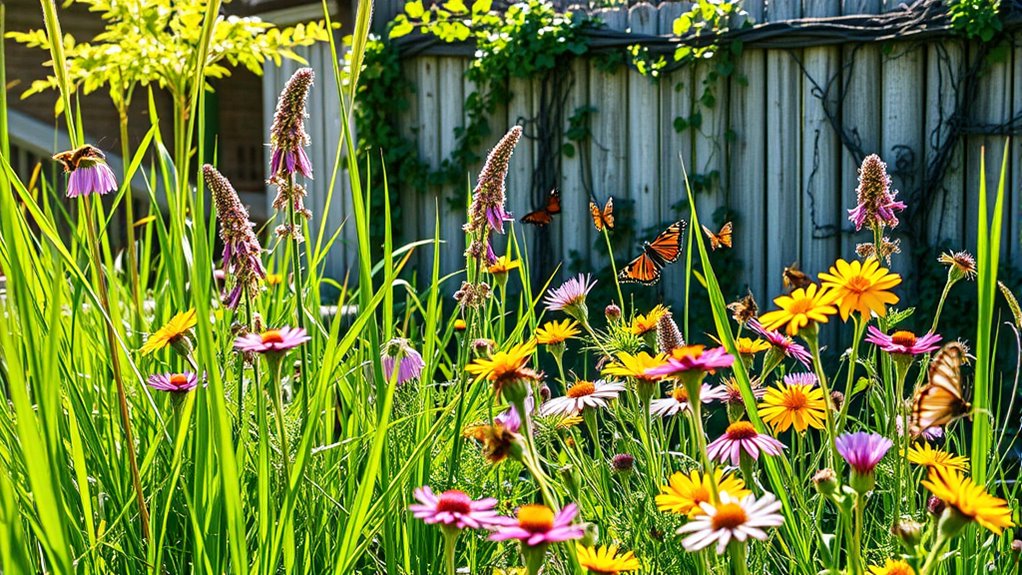Native plant landscaping offers you fantastic benefits! These plants require less water, fertilizers, and pesticides, cutting your maintenance costs. They help improve soil health, support local wildlife, and enhance biodiversity in your community. Plus, they create beautiful gardens that boost neighborhood pride. By choosing native plants, you contribute to a healthier ecosystem while potentially increasing your property value. If you’re curious about how these plants can transform your space even more, there’s plenty more to discover!
Key Takeaways
- Native plants require less water, fertilizer, and pesticides, leading to reduced maintenance costs and environmental impact.
- They enhance local biodiversity by providing essential habitats and food sources for wildlife, including pollinators.
- Deep root systems of native plants improve soil health, reduce erosion, and enhance nutrient retention.
- Landscaping with native plants can increase property values and support local economies through nurseries and gardening initiatives.
- Community engagement in native plant gardening fosters environmental stewardship and strengthens neighborhood ties.
Environmental Benefits of Native Plants

When you choose native plants for your landscaping, you’re not just beautifying your space; you’re also making a positive impact on the environment.
Native plants require less fertilizer and pesticides, significantly reducing chemical runoff into nearby water bodies. Their deep roots help maintain soil fertility and prevent erosion, stabilizing the ground effectively. Furthermore, native plants are drought tolerant, which means they conserve water resources in your garden. Additionally, they encourage sustainable gardening practices, promoting a healthier ecosystem by enhancing soil health. Incorporating native plants can also lead to greater yields in your greenhouse, as they are adapted to the local climate and soil conditions.
By providing structured habitats, they support biodiversity, attracting a variety of wildlife essential for a balanced ecosystem. Furthermore, native plants are more resilient against invasive species, preserving the integrity of local environments.
Economic Advantages of Native Plant Landscaping
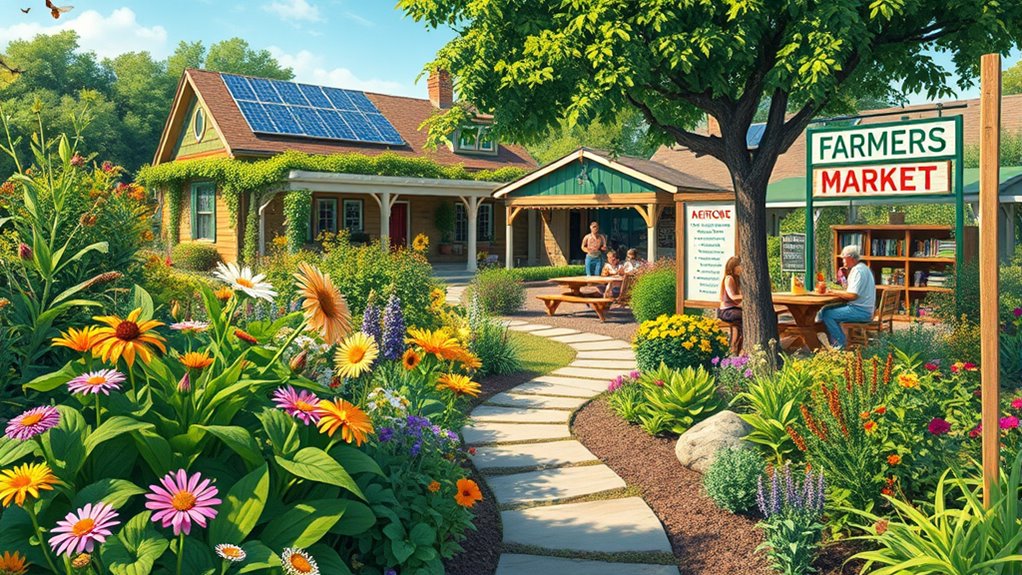
Choosing native plant landscaping not only enhances your outdoor space but also brings significant economic advantages.
First, you’ll notice lower maintenance costs since native plants typically need less watering, cutting, and fertilizing once established. This approach reduces your chemical use, lowering expenses and environmental impact. Additionally, wood as a renewable resource minimizes reliance on costly traditional landscaping practices. Furthermore, utilizing renewable energy sources can complement your landscaping efforts by powering maintenance equipment sustainably. Moreover, solar energy offers the potential to power outdoor lighting, further enhancing the sustainability of your landscape.
Additionally, native plants conserve water, decreasing those bills. You’ll also benefit from energy efficiency by minimizing lawn equipment usage. Furthermore, native plant landscaping promotes biodiversity by providing habitats for wildlife, which can enhance the overall ecological value of your property.
While initial installation costs are similar to traditional landscaping, the long-term savings are substantial. Plus, supporting local nurseries and creating specialized gardening services boosts job opportunities in your community.
Ultimately, well-designed native landscapes can increase property values, attract buyers, and contribute to local economic development.
Supporting Local Wildlife With Native Plants
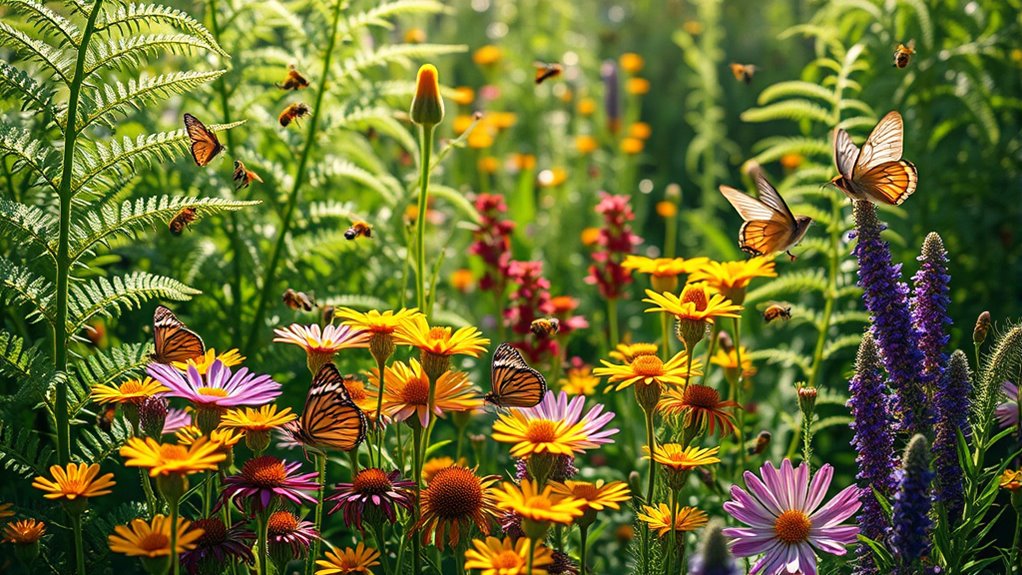
By incorporating native plants into your landscaping, you’re not just beautifying your space; you’re also creating a thriving habitat for local wildlife.
Native plants provide essential food sources for a variety of insects, birds, and mammals, enhancing local biodiversity. They co-evolve with wildlife, establishing steady relationships vital for species survival. Additionally, native plants support a variety of pollinators that rely on them for nectar and pollen. Moreover, many native plants are adapted to local water sources, ensuring they thrive with minimal irrigation. Incorporating sustainable practices in your landscaping design further promotes ecological balance. In doing so, you are also embracing holistic living, which fosters a greater connection to nature and enhances your overall well-being.
Through their leaves, branches, and flowers, native plants offer shelter, protecting wildlife from harsh conditions. By providing nectar, pollen, and seeds, they support complex food webs, ensuring year-round sustenance for local animals.
Plus, native plants attract beneficial insects like bees and butterflies, essential for pollination. This natural balance reduces the need for chemical aids, making your garden a sanctuary for wildlife while promoting a healthier ecosystem.
Enhancing Soil Health Through Native Landscaping
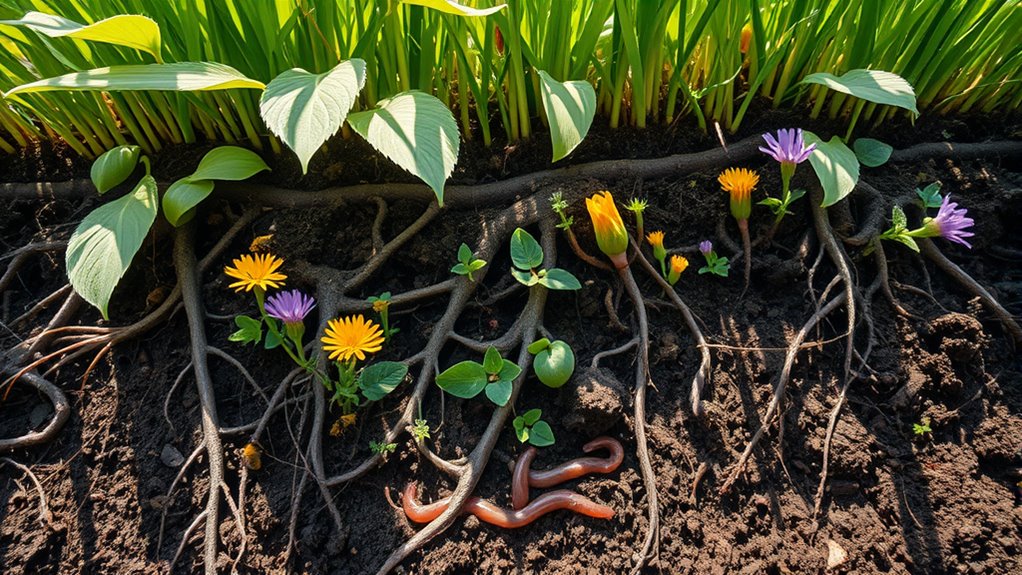
Native landscaping significantly enhances soil health, as the deep and extensive root systems of native plants break up compacted soil and improve its structure. These roots create channels for air and water, helping with root penetration and overall soil vitality. By stabilizing the soil, native plants reduce erosion and nutrient runoff. As they grow and decompose, they contribute organic matter that enriches the soil, fostering a robust microbial community essential for nutrient cycling. This symbiotic relationship boosts soil fertility and reduces the need for synthetic fertilizers. Furthermore, native plants, like legumes, fix nitrogen, enhancing soil nutrients naturally. Additionally, native plants are drought-tolerant, which means they require less irrigation, further benefiting soil health by reducing water runoff and promoting better moisture retention. Integrating organic gardening practices into native landscaping also aligns with sustainable agriculture principles, promoting ecological balance and enhancing biodiversity. Furthermore, using native plant species helps to create a resilient ecosystem that supports local wildlife and maintains the natural landscape.
Maintenance and Practicality of Native Plants

When you opt for native plants in your landscape, you’ll quickly discover their practicality and low-maintenance benefits.
Native plants thrive with less water since they’re adapted to local precipitation patterns and soil conditions. This means you won’t need to invest much in fertilizers or pesticides, as they’re also less susceptible to pests and diseases. Additionally, their lower environmental footprint makes them an excellent choice for eco-conscious gardeners. Native plants can enhance biodiversity in ecosystems, providing habitat for local wildlife and promoting a balanced environment. Moreover, native plants encourage mindful consumption by reducing the need for excessive resources. As a result, embracing native plants can also lead to lower maintenance costs over time.
During dry periods, their drought tolerance reduces your maintenance efforts. You can even cut down on mowing by allowing them to grow naturally.
While initial installation costs might be similar to traditional landscaping, the long-term savings in maintenance time and expenses can be substantial.
Embracing native plants not only simplifies your gardening but also provides an aesthetically pleasing, resilient landscape.
Ecological Stewardship and Community Benefits
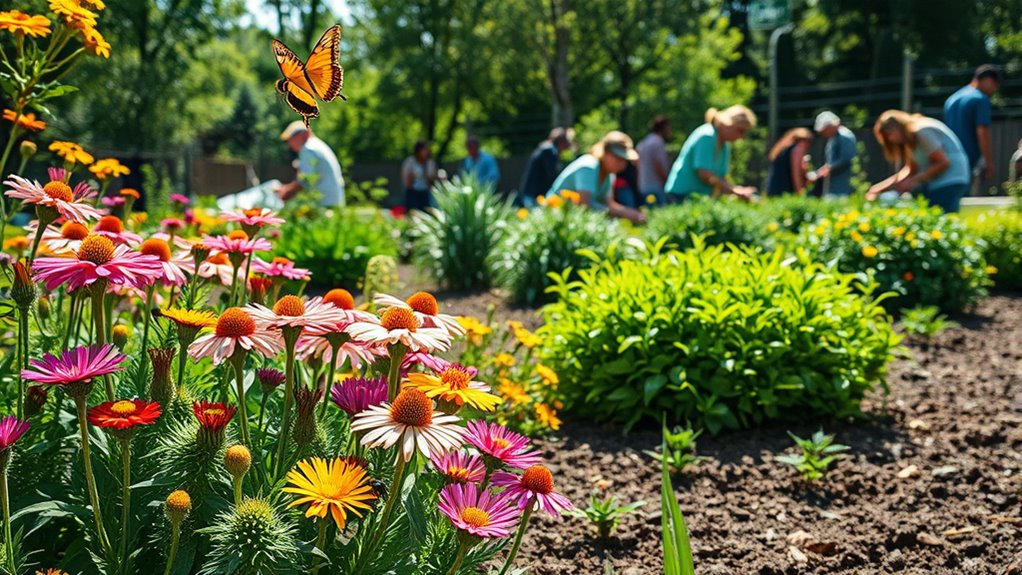
Choosing native plants not only simplifies your gardening experience but also fosters ecological stewardship and strengthens community ties.
By opting for these species, you enhance biodiversity, providing essential habitats for local wildlife, including birds and pollinators. Native plants create complex food webs, supporting various insects and animals. They also filter stormwater, reducing contaminants and promoting environmental health. Additionally, native plants can significantly reduce the need for pesticides, improving overall water and air quality. Furthermore, studies indicate that native plants support ecosystem diversity, which benefits overall environmental stability. Furthermore, stingless bees play a crucial role in pollination, further enhancing the productivity of native plant landscapes. Furthermore, cookies used on websites can enhance user experience by allowing for tailored content related to environmental information.
Furthermore, native landscapes engage your community, encouraging educational initiatives about their importance. As you cultivate these plants, you contribute to local ecosystems and create corridors for wildlife movement.
This collective effort not only beautifies your neighborhood but also strengthens your connection to nature and each other, reinforcing a shared commitment to sustainability and ecological well-being.
Frequently Asked Questions
How Can I Choose the Right Native Plants for My Area?
To choose the right native plants for your area, start by identifying your local ecoregion using maps.
Assess your garden’s conditions, including soil type, sunlight, and moisture levels. Look for plants that thrive in those specific conditions.
Mix different species to support local wildlife and ensure year-round blooms.
Finally, consider how easy they’re to care for; established natives typically need less water and maintenance.
Are There Any Specific Native Plants for Drought-Prone Regions?
Absolutely, there are several native plants perfect for drought-prone regions.
You might consider Desert Senna, which thrives in arid conditions and attracts pollinators with its bright yellow flowers.
Butterfly Weed is another great option, providing food for monarch caterpillars while requiring minimal water.
Blackfoot Daisy and Coneflower are also fantastic choices for their drought tolerance and ability to attract bees and butterflies.
These plants will help you create a beautiful, resilient garden.
Can Native Plants Attract Unwanted Pests?
Could you imagine a garden filled with unwanted pests?
While native plants typically attract fewer pests due to their natural defenses, it’s still possible for some to draw in unwanted insects.
Factors like plant diversity and local coevolution play a role in pest attraction.
However, many native plants also attract beneficial insects that help keep pests in check, creating a more balanced ecosystem in your garden.
How Long Does It Take for Native Plants to Establish?
It typically takes native plants about 2 to 5 years to establish, depending on species and site conditions.
In the first year, you’ll need to provide frequent care and watering, as the plants focus on building strong root systems.
Soil quality, light exposure, and weed competition can all influence how quickly they settle in.
Are There Any Native Plants That Bloom Year-Round?
Yes, there are native plants that bloom year-round!
For instance, Service Berry produces beautiful flowers in spring, followed by summer fruit and stunning fall foliage.
Witch Hazel surprises you with its early winter blooms, attracting pollinators.
Spicebush and Sassafras also offer seasonal interest, with their fragrant flowers and vibrant colors.
Coralberry provides berries in fall and winter, enriching your landscape throughout the year.
You’ll enjoy the continuous beauty these plants bring!
Conclusion
Incorporating native plants into your landscape not only beautifies your backyard but also bolsters biodiversity and boosts benefits for the planet. By choosing local flora, you foster flourishing ecosystems while minimizing maintenance. You’re not just planting; you’re partnering with nature, promoting a sustainable sanctuary for wildlife. So, let’s celebrate and cultivate the charm of native gardening—it’s a small step that leads to a significant, sustainable shift for our environment and community!
